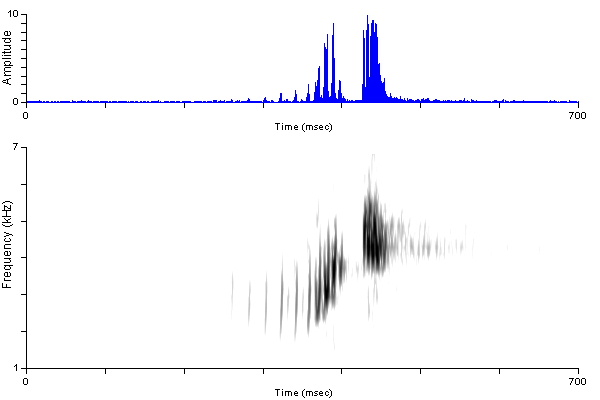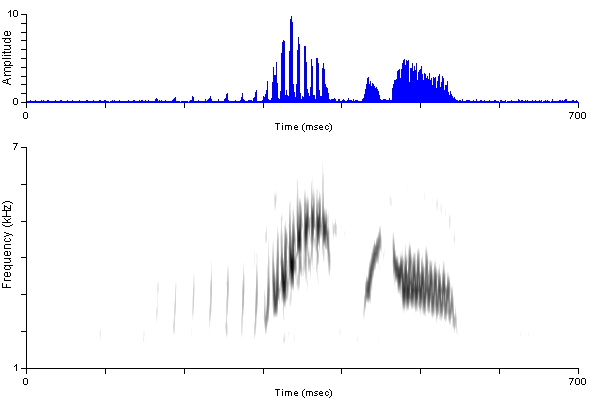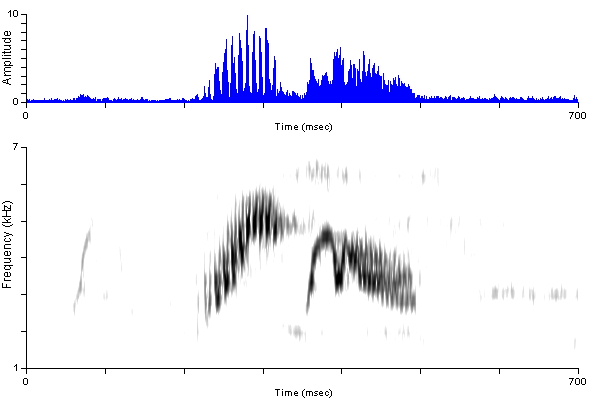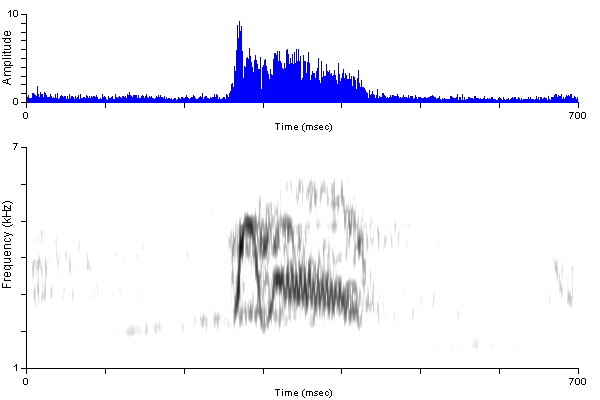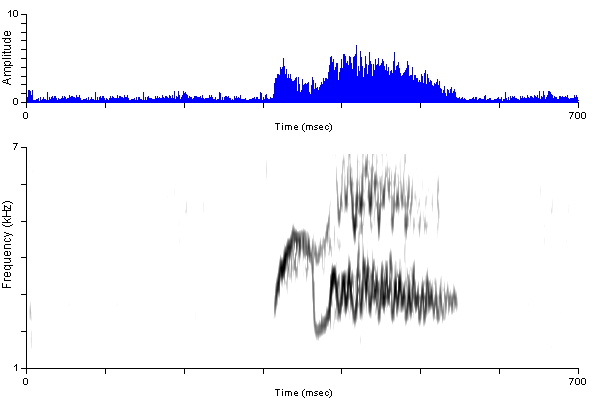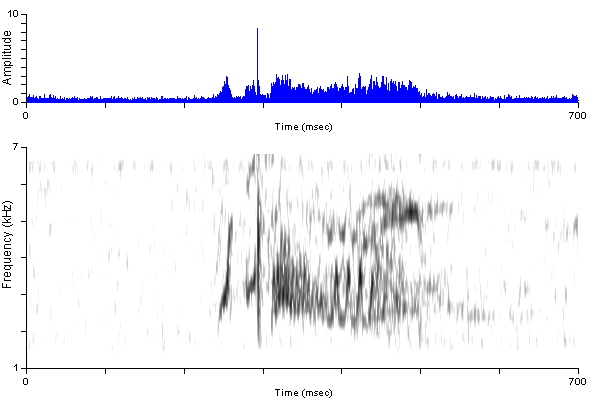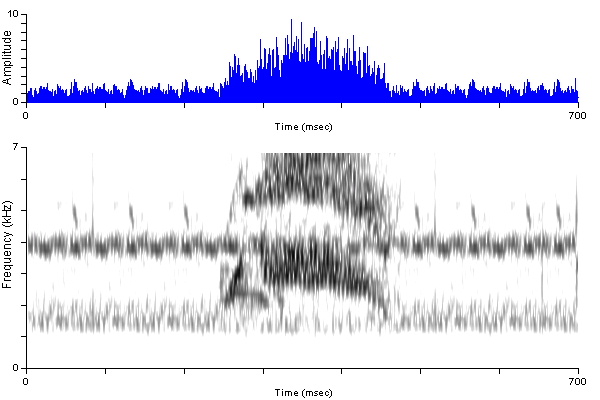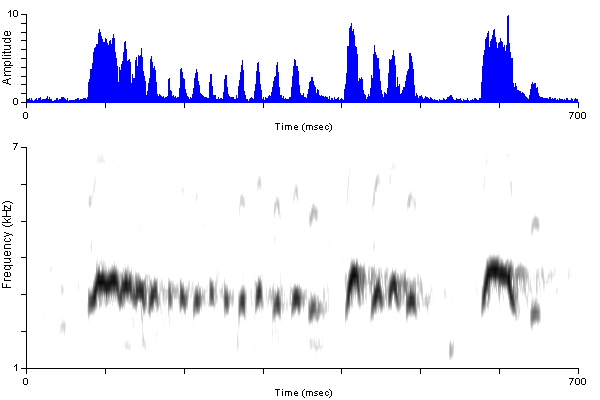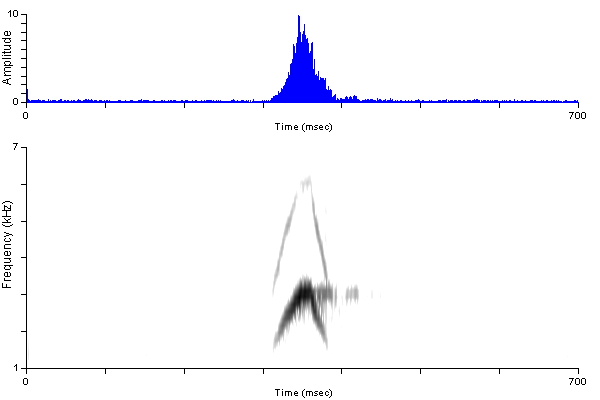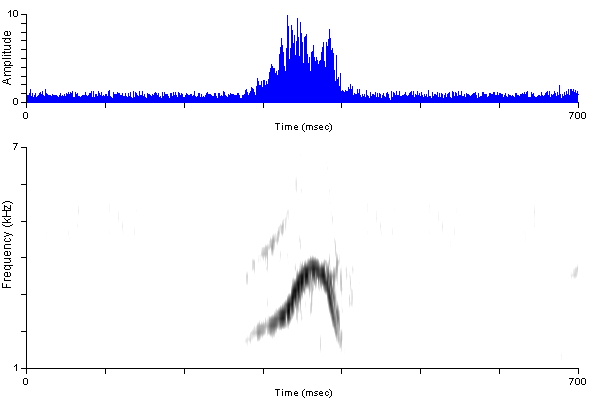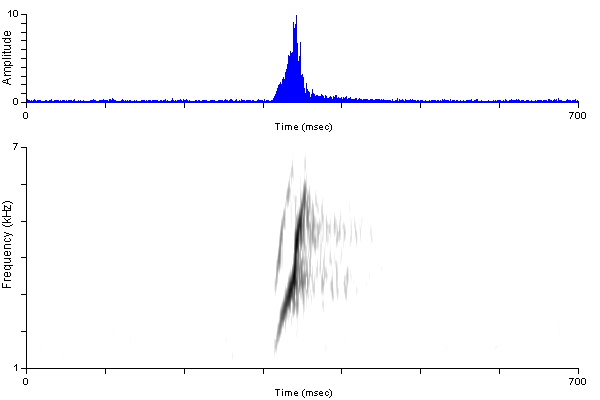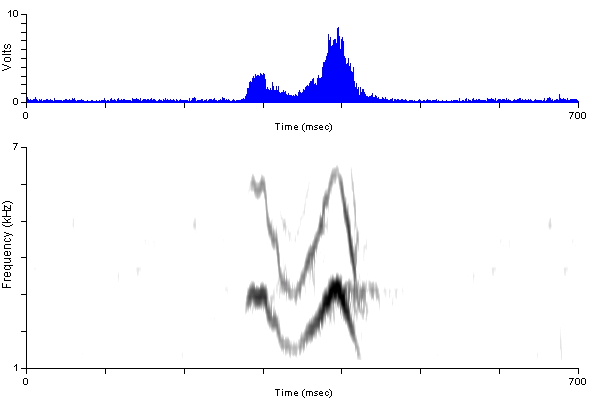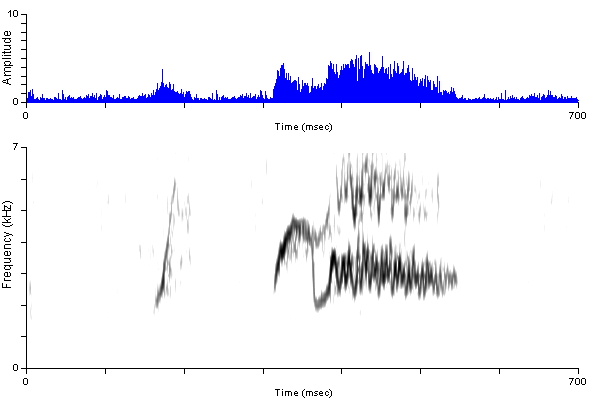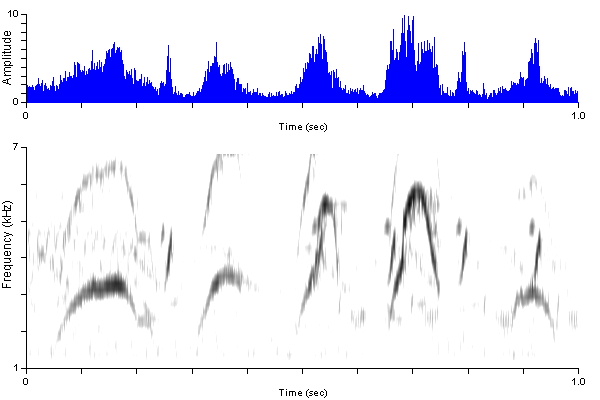|
|
SOUNDS
|
1. WIFL Fitzbew Missoula, Missoula County, Montana; 06-25-1994. Recording © Arch McCallum
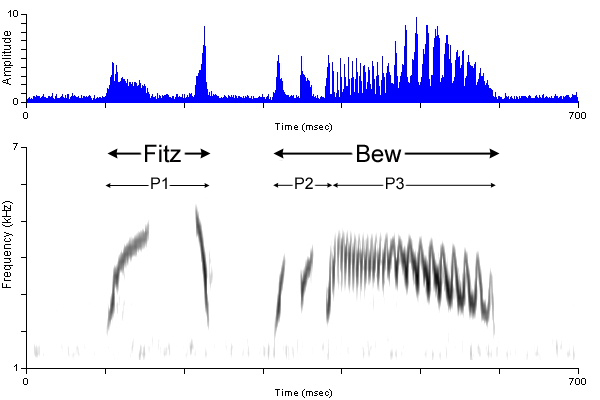
Figure 1.
WIFL Fitzbew, 6/25/1994, Missoula, Missoula County, Montana.
ã
D. A. McCallum. "P1" = Phrase 1, etc. The phrases are presumed
homologous in Fitzbew and Fizzbew.
|
|
Significance for identification of species. This is probably the song-type that most birders depend upon for identification of Willow Flycatcher. It is diagnostic, but is not always given. Knowing about, and being able to distinguish, the similar sounds (see below) from Fitzbew is a good idea. That makes it possible to identify the species by song variety in many cases. Be ready for ALFL Pip-Weeoo. Distinguishing features. The first two notes ( P1) can be resolved aurally, although occasionally they are connected, with the frequency trace rising above 7 kHz. (WIFL Whit seems derived from this phrase.) The long final phrase (P3) is typically preceded by two isolated clicks and one that is continuous with P3. These clicks no doubt contribute to the overall aural effect but are not likely to be resolved aurally by most listeners. In the western subspecies adastus and brewsteri the third click of P2 grades into the final sound, resulting in a rapid upsweep in pitch trend, as seen above; in other areas the third click is clearly separated from P3, which descends throughout its length. P3 changes form about one-third of the way through, indicative of a change in the rate and continuity of frequency modulation (periodic variation in pitch). The initial third is actually a series of very- closely-spaced "v-shaped" notes. This section of the phrase is low in amplitude in this example, but this is not typical. The final two-thirds of P3 is continuous, oscillating over a 2-kHz range every hundredth of a second. This modulation is slower than any modulation in the repertoire of the Alder Flycatcher. (In E. t. extimus this modulation is slower yet.) According to Stein (1963:24), Fitzbew is given with "two major throwbacks of the head." Nomenclature: Many names have been applied to this sound, and some of them may be more onomatopoeic, but "Fitzbew" is one of the most firmly-established birdsong names in North America. It was also used in the 1960s and early 1970s to designate the as-yet-unnamed species that eventually became the Willow Flycatcher. Fizzbew is a distinct sound, not a variant of Fitzbew. Both are stereotyped and equally common, deserving equal billing in field guides. This has been known since 1963 (Stein 1963). Similar sounds. WIFL Fizzbew: Phrase 1 is a continuously-rising buzzy trill, mirroring Phrase 3. Phrase 2 usually has one isolated click instead of two. WIFL Zweeoo: like a brief Fizzbew but beginning with a series of clicks. Luckily, ALFL Zweeoo is less similar. ALFL Pip-Weeoo: This combination sounds surprisingly similar to Fitzbew. The Pip is continuous, not broken as is "Fitz." The leading part of Weeoo is continuous, not broken into two or three clicks. Despite these differences, and its briefer duration, Pip-Weeoo can cause trouble. Combinations. Combined with Fizzbew and Creet in advertising song. |
|
2. WIFL Fizzbew Deer Lodge, Powell County, Montana; 07-10-2007. Recording © Arch McCallum
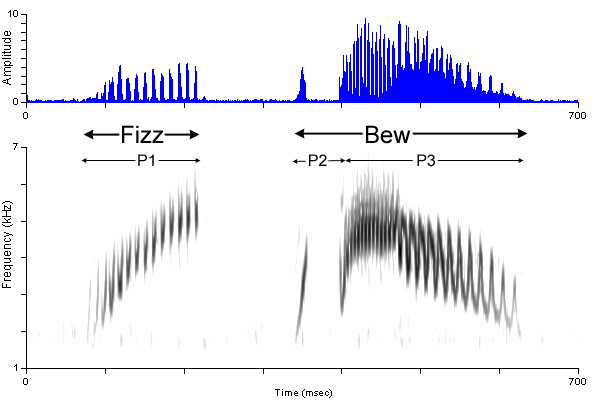
Figure 2.
WIFL Fizzbew, 7/10/2007, Deer Lodge, Powell County, Montana.
ã
D. A. McCallum. "P1" = Phrase 1, etc. The phrases are presumed
homologous in Fitzbew and Fizzbew.
|
|
Significance for identification of species. This song-type is very similar in duration, bandwidth, and pitch-trend to Fitzbew, but being able to distinguish the two is useful for field identification. The use of two similar song-types by Willow Flycatcher distinguishes it from Alder Flycatcher. Also, Fizzbew is very similar to WIFL Zweeoo (Figure 4, Figure 5), so recognizing the latter certainly requires distinguishing Fizzbew from Fitzbew. Because of the rolling, ascending "Fizz" phrase, Fizzbew is more similar to ALFL Feebeeo than is Fitzbew. Be ready for a bird giving Fizzbew only, which is unlikely but possible. Distinguishing Features. Field guides typically mention Fitzbew, then describe it as variable. That is not actually an accurate characterization of WIFL song-types. The three discrete song-types are each quite stereotyped, and not very variable at all. Fizzbew typically rises to a higher frequency (pitch) than Fitzbew. The "Bew" (P2 + P3) of Fizzbew is very similar to the "Bew" of Fitzbew and appears homologous to it, but P2 typically has 1 isolated click (plus one basted to P3) instead of 2 and the "v-shaped" notes in the first third of P3 are consistently farther apart than in the corresponding part of Fitzbew. As with Fitzbew, the onset of P3 differs between the northern western populations (adastus and brewsteri) and other populations (eastern traillii and campestris and southwestern extimus). P1 is a trill, an ascending series of very brief (5 msec), "v-shaped" notes separated by equivalent (6 msec) silent gaps. In contrast, the "burry", rising s of the Alder Flycatcher are all continuous sounds with zigzag spectrographic traces, like the final, descending, part of "Bew." Nomenclature: Some field guides do not name this sound, perhaps leading many birders to assume that the song (Fitzbew) of WIFL is more variable than the song (Feebeeo) of ALFL. Actually, Fitzbew and Feebeeo are equally stereotyped, but the song repertoire of WIFL is more diverse, with three song types rather than one.
Similar sounds. WIFL Fitzbew: Starts with two loud clicks, and P2 has 2 isolated clicks instead of 1. WIFL Zweeoo: very similar, but noticeably shorter. The similarity is in the first, ascending phrase. In Fizzbew, the "Bew" is long and seems accented, while in Zweeoo the final phrase is short and insignificant. ALFL Feebeeo: Similar enough to confuse; rely on songtype variety in WIFL and ascending second phrase of Feebeeo. If you have very good temporal discrimination, listen for the click in the middle of Fizzbew, which is absent in ALFL Feebeeo. |
|
Figure 3. WIFL Creet, 6/14/2006, Elkton, Douglas County, Oregon. ã D. A. McCallum Significance for identification of species. This brief sound is easily overlooked, but it is a full-fledged element of the advertising song of Willow Flycatcher. Hearing it along with Fitzbew and/or Fizzbew cinches the identification of Willow Flycatcher. It is not likely to be given repeatedly without Fitzbew or Fizzbew. It is quite similar in duration, pitch trend, and quality to ALFL Zweeoo, but Alder Flycatcher usually does not use its Zweeoo call in its singing performances. ALFL Zweeoo and WIFL Creet are easily distinguished with spectrograms. Distinguishing features. Creet begins with a series of faint clicks (like ALFL Zweeoo), which are followed by brief "v- shaped" notes very similar to those in the opening "fizz" of Fizzbew. Then there is a silent gap. This is real, and is consistently present throughout the range of the Willow Flycatcher. The final part is a series of very brief "v-shaped" notes that may or may not be connected. According to Stein (1963:24), Creet is given with "a single throwback of the head." Similar sounds. ALFL Zweeoo: Similar in duration and bandwidth, but continuous. WIFL Zweeoo: First phrase is continuous, without break seen above, and it has a second, descending, phrase. ALFL Feebeeo: "Fee" phrase is similar in duration and bandwidth but continuous, and the entire sound is much longer. |
|
Figure 4. WIFL Zweeoo, 7/10/2007, Deer Lodge, Powell County, Montana.. ã D. A. McCallum .The same bird gave Fitzbew and Fizzbew. Significance for identification of species. This is the sound that is most likely to lead to the misidentification of a Willow Flycatcher as an Alder. This is a serious issue on the west coast, where Alders probably are rare spring migrants, but under-reported. When used, Zweeoo may be the only field mark available. It is used mostly for nest defense, but sometimes is given repetitively from a conspicuous perch, in the manner of advertising song. Its aural similarity to ALFL Feebeeo, combined with the repetition of the same call, which is reminiscent of singing by Alder Flycatcher, invite error. The Southwestern Willow Flycatcher's version of this call (not presented here) appears sufficiently distinctive to allow identification of that subspecies from this call alone. Distinguishing features. The initial, ascending half of the call begins like a WIFL Creet (with faint clicks) and then resembles the "Fizz" of Fizzbew (with an ascending series of closely- spaced "V-shaped" notes). The absences of a silent gap and of more closely-packed notes at the end distinguish this half from Creet. The second half is nothing more than the call-type called Weeoo by Stein (1963) and Writ-tu by Sedgwick (2000). WIFL Weeoo is similar to ""Bew"", but is consistently different as follows: (1) The first part of P3 of "Bew" is absent in Weeoo. (2) The descending buzz in Weeoo covers the same frequency range as the final part of "Bew"," but each oscillation lasts 5-6 msec rather than 10 msec, i.e., it is modulated faster. ALFL Weeoo is similar to but distinguishable from WIFL Weeoo (Writ-tu). ALFL Zweeoo is continuous, and easily distinguished from this call. Similar sounds. Fizzbew: Similar, but noticeably longer in duration then Zweeoo. In Fizzbew, the second phrase ("Bew") starts at a higher pitch than the end of the first phrase ("Fizz"); the second phrase of Zweeoo starts lower than the end of the ascending first phrase. ALFL Feebeeo: Also noticeably longer in duration. The "Fee" and "O" parts are not very different from the two parts of WIFL Zweeoo. It is the middle, "Bee" phrase that sets Feebeeo apart from WIFL Zweeoo. It makes the entire sound longer, and rises to a higher pitch than Zweeoo, giving Feebeeo a more ascending and higher sound. Creet: Creet is similar to first half of Zweeoo, but is broken rather than continuous. WIFL Weeoo and ALFL Weeoo: both resemble second half of this call (see above). Usage. Often a stand-alone call (repeated, not mixed with other call- types). May be combined with Whit (which may be given by the mate), and occasionally with rare calls that are not stereotyped parts of the repertoire. |
|
Figure 5. WIFL Zweeoo, 6/6/2006, Rhinehart Lane, Union County, Oregon. ã D. A. McCallum. Numerous Zweeoos and some Whits were heard from this location. Note the faint Whit (made by a nontarget bird) before the Zweeoo. It is audible on the cut. This example has no leading clicks, and the leading part of the second half is continuous. Otherwise it is similar to the example in Figure 4. |
|
Figure 9. WIFL Weeoo (=Writ-tu), 5/19/1963, Columbus, Franklin County, Ohio. Borror Laboratory of Bioacoustics Cut 6384 ã Borror Laboratory of Bioacoustics, used with permission. This is a noisy recording; WIFL Weeoo is rare in nature. Significance for identification of species. This call is not very useful for identification, because it is rarely given. It is, however, distinguishable from any sound of the Alder Flycatcher. The Southwestern Willow Flycatcher's version of this call (not presented here) appears sufficiently distinctive to allow identification of that subspecies from this call alone. WIFL Weeoo is a component of WIFL Zweeoo, which is given fairly commonly. Distinguishing features. Essentially a Whup basted to a buzz (Sedgwick 2000). The buzz is uneven in frequency bandwidth. WIFL Weeoo is the second half of WIFL Zweeoo. Nomenclature: This sound is called "Writ-tu" by Sedgwick (2000). Although that name may be more onomatopoeic than Stein's (1963) Weeoo, I prefer to retain the latter because of the similarity between WIFL Weeoo and ALFL Weeoo. They appear to be homologous. WIFL Weeoo may be thought of as simply a part of WIFL Zweeoo, but a similar relationship between ALFL Weeoo and Zweeoo does not hold. WIFL Weeoo is rare, whereas WIFL Zweeoo is fairly common. Similar sounds. ALFL Weeoo: final part has even frequency modulation, at slightly slower rate, over narrower bandwidth, initial part rounded and drawn out, dominating the sound; sounds more like a Double-Peak than this. Some WIFL Weeoo (see Figure 10) are quite similar to ALFL Weeoo and may not be safely distinguishable aurally. WIFL Double-Peak: has two smooth Pips, the initial Pip here is too brief to register. Usage. Occasionally heard, usually interspersed with songs and Trill in hyperactive behavior, perhaps during incursions into calling bird's territory. |
|
Figure 10. WIFL Weeoo (=Writ-tu), 7/09/2006, Nutria, McKinley County, New Mexico. ã D. A. McCallum. This sound was digitally extracted from the clip presented with Figure 23 to allow clearer comparison with other examples. Distinguishing features. This example of Weeoo is more rounded at the beginning, and may not be safely distinguishable from ALFL Weeoo. Spectrographically, the longer duration and uneven bandwidth of the buzzy (frequency-modulated) part distinguish it from ALFL Weeoo. |
|
Figure 11. WIFL "Bew," 7/18/2004, Izaak Walton Road, near Eugene, Lane County, Oregon. ã D. A. McCallum. Significance for identification of species. Occasionally a "Bew" appears by itself and is used like Weeoo. Although such "Bews" tend to be flatter (spectrally) than "Bews" that occur with "Fitz" or "Fizz," they are clearly recognizable as such spectrographically, and readily identified to species. Hearing this rare sound without other cues, though, could be confusing. Distinguishing features. This sound is longer in duration than Weeoo, and has both P2 and P3 of "Bew" (see Figures 1 and 2). P3 does not descend in pitch, unlike P3 of Fitzbew and Fizzbew. In this respect, this sound resembles Weeoo in comparison to the second half of Zweeoo. Probably these patterns illustrate a phonological rule: if the first part doesn't ascend, the second part doesn't have to descend. When there is no first part, as in Weeoo, pitch trend is flat. This example is probably derived from Fitzbew rather than Fizzbew, in that is has two introductory notes. Similar sounds. This sound has the same relationship to Fitzbew that WIFL Weeoo has to WIFL Zweeoo. Usage. Like WIFL Weeoo, along with trills in hyperactive calling. May also be associated with perch changes. |
|
Figure 13. WIFL Churr, 7/01/2007, Hooper Lane, Henderson County, North Carolina. ã D. A. McCallum. Significance for identification of species. This sound is so rarely used that its significance is difficult to gauge. It probably is not distinguishable from ALFL Churr. This sound may not deserve classification as a distinct call type. Distinguishing features and nomenclature. Stein (1963) gave the name "Churr" to strings of Pips that are punctuated with rough sounds, such as Weeoo. It seems better to follow Sedgwick (2000) and interpret these as combinations of trills and various rough sounds from the repertoire. In the Alder Flycatcher, some of these rough sounds are distinguishable from Zweeoo and Weeoo, and I refer to them as "Churr." The consistent feature of ALFL Churr, which I judge to be used fairly commonly, is the evenly modulated buzz lasting around 100 msec and the absence of the high-arching initial sweep that characterizes Weeoo. Stein (1963) figures similar sounds for Willow Flycatcher, but I wonder if they are misidentified ALFL calls. In my experience, such sounds are rare in WIFL, and this is the only example I have found that is not interpretable as WIFL Weeoo or WIFL Bew, which is used by this species in the manner of ALFL Churr. Similar sounds. ALFL Churr: very similar. WIFL Weeoo has an initial chevron, as does ALFL Weeoo. Usage. With Pips and Trills, the entire indeterminate combination called "Churr" by Stein.
|
|
Figure 14. WIFL Trill, 6/6/2007, Princeton, British Columbia. ã Andrew Rush, used with permission. Significance for identification of species. This call is not useful for distinguishing WIFL and ALFL, or, for that matter distinguishing Traill's Flycatchers from several other empids with similar trills in their repertoires. Distinguishing features. Trill is a series of Pip-like notes that are shorter than individual Pips or Whups. They are sometimes combined with Weeoo. This example is roughly 1 kHz higher in pitch than the example of ALFL Trill in the next figure. I don't know if there is a consistent difference, because I have found no other examples of ALFL Trill. If WIFL Trill is higher, it is surprising, as WIFL Pip and Double-Peak are consistently lower than the ALFL equivalents. Nomenclature. Stein (1963) used the name "Churr" for series that are characterized mainly by trills, but also include buzzy sounds such as Churr and Weeoo. Sedgwick proposed the name Trill for the series of Pip-like notes and referred to the sounds I call Weeoo (Stein 1963) as "Writ-tu." Similar sounds. ALFL Trill is indistinguishable. Similar-sounding trills are given by Gray and Hammond's Flycatchers. Usage. Often with Whup, sometimes with Weeoo. |
|
Figure 17. WIFL Whup (Pip), 6/6/2007, Princeton, British Columbia. ã Andrew Rush, used with permission. Significance for identification of species. Not very useful, because of similarity to ALFL Pip. The existence of this sound in the WIFL repertoire is not widely appreciated. Like Double-Peak, it is rare. Distinguishing features and nomenclature. Stein (1963) called this call "Pit." First, I change his "Pit" to "Pip" (see ALFL Pip), because one of the few generalities about human transliteration of bird sounds is that most birders hear an up-down chevron as ending in "p," while hearing an ascending trace (see WIFL Whit) as ending in "t." Sedgwick (2000) changed Stein's "Pit" to "Whup," for WIFL. I follow that decision, because ALFL Pip and this sound really do sound a little different, if one is paying attention. I think the aural difference is due more to the difference in duration than to the difference in pitch. I would be less inclined to go with Sedgwick's name change if all Whups were like this one. They are not. Many are higher in pitch, more drawn out in duration, and less symmetrical. It is really a stretch to call those sounds "Pip." Finally, the more extreme examples of Whup grade into Whit by dropping all or most of the descending part. It seems likely that the Whup-Whit complex of WIFL is homologous with Pip of ALFL. It is interesting that the examples that sound and look most like ALFL Pip are so rare. Possibly the ancestral Pip-like form has become vestigial, replaced by the divergent Whit. Similar sounds. ALFL Pip: More symmetric, shorter in duration, and higher in pitch than this sound. Usage. With Trill and Churr in indeterminate series. Trills are essentially series of short Pips. |
|
Figure 18. WIFL Whup, 7/18/2004, Izaak Walton Road, near Eugene, Lane County, Oregon. ã D. A. McCallum Significance for identification of species. This is a distinctive sound, and should serve to distinguish Willow Flycatcher from all other empids except the two "Pippers," Alder and Hammond's. On present evidence, most Whups are longer in duration and more asymmetrical than Alder Pip, but some examples of WIFL Whup are probably too close to call, making it somewhat problematic to identify out-of-range Alders on the basis of Pip alone. Distinguishing features. Asymmetric pitch trend, peak frequency around 4 kHz. Similar sounds. The more drawn-out Whups, like this one, are longer than the Pips of Alder and Hammond's. Duration plus the asymmetric pitch trend give Whup a distinctive aural quality that distinguishes it from most other empid sounds. Acadian Flycatcher call note: similar in form but reaches 6 kHz. Usage. Often given repeatedly by a rather excited bird, perhaps defending territory or nest from a potential predator. May be interchangeable with Whit, which is used similarly. |
|
Figure 19. WIFL Whit, 8/2/2007, Izaak Walton Road, near Eugene, Lane County, Oregon. ã D. A. McCallum Significance for identification of species. When the bird has been visually identified as Traill's Flycatcher, the use of dry Whits like this one would, on present knowledge, verify that it is a Willow Flycatcher. Whups are more problematic, because they grade into Pip-like sounds that could be made by an Alder Flycatcher. Distinguishing features. It is not clear whether Whit is a distinct call from Whup. Most Whits approach 6 kHz in frequency, like this one, and most Whups peak below 5 kHz, like the one in the preceding figure. Some Whits do have a partial descending arm, however, so it is possible that the extremes pictured here are part of a continuum, and that individuals simply vary in the form of their Whup/Pip. Longitudinal study of known individuals is needed to sort these possibilities out. Kaufman (1990:206) wrote, "The Whit of Willow gives the illusion of a slight rising inflection, and it seems to have the hardest or most emphasized sound at the end." It's not illusion; Kaufman correctly perceived the rising pitch trend of this sound, despite its lasting only 1/20 of a second. Many onomatopoeic renderings of bird sounds are problematic, but renderings that end with "t" are typically matched by spectrograms that ascend at the end of the note. If the spectral contour turns down beyond the peak, the sound is "softened" or "thickened," and if the descending arm matches the ascending arm in pitch change, the sound is usually transliterated with a terminal "p," as in "Pip" and "Whup". Similar sounds. Alder Flycatcher has no Whit in its repertoire. Very similar to Whit notes of Least, Dusky, Gray, and Buff-breasted Flycatchers. "Thicker" and more robust than all of those. Having a partial descending arm makes a WIFL Whit even more distinctive, as this feature is found in none of the Whits of other species. Usage. Mild alarm and perhaps nest or territorial defense. Both members of pair may Whit, or one may Whit while the other gives Weeoo or Zweeoo. |
|
Figure 21. WIFL Double-Peak, 6/6/2007, Princeton, British Columbia. ã Andrew Rush Significance for identification of species. A rarely-heard sound from Willow Flycatchers, but the homologue is commonly used by Alder Flycatchers. For auditors familiar with the Alder Flycatcher, this sound may be misleading or confusing. Those not familiar with the sister species are also likely to be confused, because they likely have never heard this sound. I have never heard it in the wild. I know of two recordings, one from BC, presented here courtesy of Andrew Rush, and one from the Southwestern Willow Flycatcher. This WIFL call- type is not presented in any published sound collection that I know of, but it was mentioned by Stein (1963) and is represented on a training CD for Southwestern Willow Flycatcher workers provided by Mark Sogge of the USGS. Distinguishing features. Essentially two Whups basted together. The first Whup may be incomplete, often starting, in the two examples I have seen (one from Southwestern Willow Flycatcher, E. t. extimus, one from British Columbia and hence probably brewsteri), near the peak. Note the presence here of a very loud harmonic, which is not obvious in the example of ALFL Double-Peak. ALFL Double-Peaks often do not have loud harmonics. Considering that harmonics in bird vocalizations have to be "intentionally" filtered out, the absence of a harmonic in ALFL may be an evolved isolating mechanism. Similar sounds. ALFL Double-Peak: Higher, but other field marks should be sought to confirm identification. Hammond's Flycatcher has an infrequently- heard call, Whezee, which is spectrographically similar. As Hammond's and the Traill's complex are in different clades of Empidonax, these similarities are probably convergent rather than being homologous. Usage. With Trill, Whup, and songs in the source tape for this sample. |
|
Figure 23. WIFL Whit and Weeoo, 7/09/2006, Upper Nutria, McKinley County, New Mexico. ã D. A. McCallum. These are two independent calls, which are sometimes combined. In this case, they could have been made by different birds, as two birds were present, but this combination is common (Sedgwick 2000), and his Figure 2e shows the two with equal amplitude, more likely made by the same bird. Significance for identification of species. Has the potential to confuse. If not seen, the bird may not be recognized as in the Traill's Complex, and the observer could spend time trying to shoe-horn the Weeoo into the repertoires of another of the "whitting" empids (i.e., Least, Dusky, Gray, Buff-breasted) (pers. obs.). For those familiar with Traill's call notes (Whit, Whup, Pip), the Whit portion should keep them out of trouble. Distinguishing features. The Weeoo is spectrographically, and aurally (with practice) distinct from ALFL Weeoo. Similar sounds. ALFL Pip-Weeoo: has a Pip not a Whit, and its Weeoo is cleaner. WIFL Fitzbew: has two introductory clicks instead of one, longer in duration. |
|
Figure 26. WIFL variable twitter, 7/01/2007, Hooper Lane, near Hendersonville, Henderson County, North Carolina. ã D. A. McCallum. Significance for identification of species. Probably not useful, both because it is not a stereotyped call, and because of similar calls by ALFL. Distinguishing features. Variable structure of notes. WIFL gives a variety of unstructured utterances of this sort. Similar sounds. ALFL undescribed descending twitter. |
All recordings presented here are the property of the recordists and are used here with the permission of the copyright holder. The name of the copyright holder appears above each spectrogram.
Spectrograms, text, design, and source code are the property of AppliedBioacoustics. © 2006-2008 AppliedBioacoustics.
